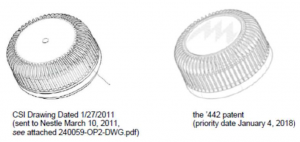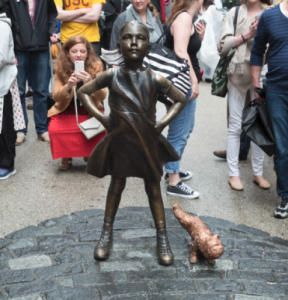|
Patent No. |
Title |
| 1 |
D947,327 |
Faucet spout |
| 2 |
D947,326 |
Faucet handle |
| 3 |
D947,323 |
Faucet body |
| 4 |
D947,322 |
Faucet sprayhead |
| 5 |
D947,321 |
Faucet sprayhead |
| 6 |
D947,017 |
Wall-engaging device for a gate |
| 7 |
11,290,301 |
Secure engine communication |
| 8 |
11,289,946 |
Method and system of uniform wireless power distribution within a chamber |
| 9 |
11,289,850 |
Electrical connector having latch |
| 10 |
11,289,755 |
System and method for thermally robust energy storage system |
| 11 |
11,289,423 |
Ultra-thin diffusion barrier |
| 12 |
11,289,321 |
Ion traps that apply an inverse mathieu q scan |
| 13 |
11,289,194 |
Modular location engine for tracking the locations of assets in a clinical environment |
| 14 |
11,287,414 |
Sample dispenser including an internal standard and methods of use thereof |
| 15 |
11,287,402 |
Automated method for maintaining a clinical diagnostics system |
| 16 |
11,287,172 |
Freezer dehumidification system |
| 17 |
11,286,952 |
Diffusion system configured for use with centrifugal compressor |
| 18 |
11,286,917 |
Motor drive system and method |
| 19 |
11,286,881 |
Gas turbine engine with reversible heat exchanger |
| 20 |
11,286,878 |
Variable area nozzle exhaust system with integrated thrust reverser |
| 21 |
11,286,865 |
Gas turbine engine with variable pitch fan and variable pitch compressor geometry |
| 22 |
11,286,835 |
System and methods for controlling flow distribution in an aftertreatment system |
| 23 |
11,286,827 |
System and method for determining reductant delivery performance |
| 24 |
11,286,826 |
Integrative reductant system and method using constant volume injection |
| 25 |
11,286,812 |
Turbine shroud assembly with axially biased pin and shroud segment |
| 26 |
11,286,802 |
Turbine shroud segment having a seal segment perimeter seal with separated buffer cavities |
| 27 |
11,286,798 |
Airfoil assembly with ceramic matrix composite parts and load-transfer features |
| 28 |
11,286,794 |
Erosion-resistant coating with patterned leading edge |
| 29 |
11,286,707 |
Opening and closing system |
| 30 |
11,286,690 |
Combination lock |
| 31 |
11,286,249 |
Pyrrolidine compounds |
| 32 |
11,286,175 |
Fluid stream management systems and methods thereof |
| 33 |
11,285,617 |
Modular articulating gripper |
| 34 |
11,285,540 |
Method for manufacturing parts or devices and forming transition layers facilitating removal of parts and devices from build-plates |
| 35 |
11,285,411 |
Self-adjusting air management valve for a filter assembly |
| 36 |
11,285,294 |
Introducer with sheath having a withdrawal support wire |
| 37 |
11,285,049 |
Two layer wound dressings including removable upper layer |
| 38 |
11,285,022 |
Spinal implant system and method |
| 39 |
11,285,019 |
Expandable spinal implant system and method |
| 40 |
11,285,014 |
Expandable inter-body device, system, and method |
| 41 |
11,284,928 |
Surgical implant and method of use |
| 42 |
11,284,924 |
Adjustable spinal implant, system and method |
| 43 |
11,284,917 |
Surgical access assembly and method of using same |
| 44 |
11,284,908 |
Adjustable acetabular reamers and methods |
| 45 |
11,284,884 |
Method and apparatus for coupling soft tissue to a bone |
| 46 |
11,284,817 |
Method for determination of an analyte concentration in a body fluid and analyte concentration measurement device |
| 47 |
11,284,815 |
Bolus calculator time keeping between mobile phone application and bG meters |
| 48 |
11,284,726 |
Barrier for mattress and bed deck |
| 49 |
11,284,655 |
Surgical helmet |
| 50 |
11,284,620 |
Picolinamide compounds with fungicidal activity |
| 51 |
11,284,603 |
System and method for delivering nutrients to recently hatched chicks |
| 52 |
D946,715 |
Faucet handle |
| 53 |
D946,714 |
Faucet handle |
| 54 |
D946,713 |
Faucet body |
| 55 |
D946,708 |
Faucet sprayhead |
| 56 |
D946,591 |
Display screen with graphical user interface for a glucose management system |
| 57 |
D946,590 |
Display screen with graphical user interface for glucose management |
| 58 |
11,283,264 |
Short-term reserve product for implementation on an electric power grid, and associated method |
| 59 |
11,282,703 |
Preparation of an array of ultra-narrow nanowires on functionalized 2D materials and uses thereof |
| 60 |
11,282,484 |
Illuminated acoustic device |
| 61 |
11,282,365 |
Customized bed exit warnings to modify patient behavior |
| 62 |
11,282,311 |
Door lock sensor and alarm |
| 63 |
11,281,429 |
Ternary in-memory accelerator |
| 64 |
11,280,795 |
Quantitative profiling of progesterone metabolites for the prediction of spontaneous preterm delivery |
| 65 |
11,280,756 |
Method for detecting an interferent contribution in a biosensor |
| 66 |
11,280,742 |
Analyte measuring system and method |
| 67 |
11,280,727 |
Depth-resolved mid-infrared photothermal imaging of living cells and organisms with sub-micron spatial resolution |
| 68 |
11,280,574 |
Arrow rest |
| 69 |
11,280,534 |
Cooling apparatus and method of using the same |
| 70 |
11,280,396 |
Fire resistant gearbox housing |
| 71 |
11,280,247 |
Pneumatic system and method for heating compressor oil and/or components of the system |
| 72 |
11,280,206 |
Turbine shroud segment with flange-facing perimeter seal |
| 73 |
11,280,130 |
Top-hanging sliding door including wedge design top seal |
| 74 |
11,280,109 |
Keycam assembly |
| 75 |
11,280,091 |
Structural joists and methods to manufacture the same |
| 76 |
11,280,057 |
System and method for attaching implements to different skid steer mounts |
| 77 |
11,279,658 |
Compositions for improved concrete performance |
| 78 |
11,279,266 |
Motor home chair lift |
| 79 |
11,279,213 |
Truck cap |
| 80 |
11,279,075 |
System and method for sterilization of medical instruments within a hydrogen peroxide sterilization process |
| 81 |
11,278,883 |
Sample processing systems and methods |
| 82 |
11,278,786 |
System and method for incentivizing and quantifying patient mobility |
| 83 |
11,278,760 |
Physical rehabilitation and exercise devise |
| 84 |
11,278,666 |
Medication infusion device |
| 85 |
11,278,497 |
Co-spray drying of meropenem and colistin and the uses thereof |
| 86 |
11,278,457 |
Incontinence detection optimization using directional wicking |
| 87 |
11,278,431 |
Spinal implant system and method |
| 88 |
11,278,391 |
Graft having at least one woven taper |
| 89 |
11,278,372 |
Surgical sterilization system and method |
| 90 |
11,278,325 |
Surgical instrument and method |
| 91 |
11,278,238 |
Wearable sensor device and analysis platform for objective outcome assessment in spinal diseases |
| 92 |
11,278,125 |
Topper with targeted fluid flow distribution |
| 93 |
D946,147 |
Surgical retractor |
| 94 |
D946,125 |
Faucet handle |
| 95 |
D946,124 |
Faucet handle |
| 96 |
D946,123 |
Faucet |
| 97 |
D946,122 |
Faucet |
| 98 |
D946,121 |
Faucet |
| 99 |
D946,116 |
Faucet sprayhead |
| 100 |
D946,115 |
Faucet sprayer |
| 101 |
|
|
| 102 |
D946,111 |
Shower system |
| 103 |
D946,104 |
Collapsible table tennis table |
| 104 |
D946,087 |
Card for a card game |
| 105 |
D945,975 |
Handheld controller |
| 106 |
D0945,886 |
Container |
| 107 |
11,277,081 |
Device and method for switching in and out a start winding of a single phase ac motor |
| 108 |
11,276,413 |
Audio signal encoding method and audio signal decoding method, and encoder and decoder performing the same |
| 109 |
11,275,123 |
System and method for electric meter outage time detection |
| 110 |
11,275,065 |
Automated clinical diagnostic system and method |
| 111 |
11,274,829 |
Shell and tiled liner arrangement for a combustor |
| 112 |
11,274,707 |
Customizable light-up device |
| 113 |
11,274,631 |
Methodology for minimizing aerodynamic buzz in an exhaust nozzle |
| 114 |
11,274,630 |
Exhaust nozzle with vane support structure for a gas turbine engine |
| 115 |
11,274,605 |
System and method for shimming a bevel gear in an IGB on a gas turbine without removal of the bevel gear |
| 116 |
11,274,567 |
Keystoned blade track |
| 117 |
11,274,470 |
Motorized trim |
| 118 |
11,274,468 |
Modular and interchangeable lock plug |
| 119 |
11,274,315 |
Chimeric insecticidal proteins |
| 120 |
11,274,311 |
Plant promoter for transgene expression |
| 121 |
11,273,962 |
Tamper-evident closure |
| 122 |
11,273,959 |
Container with lid and detachable lid collar |
| 123 |
11,273,925 |
Thermal management system and method for cooling a hybrid electric aircraft propulsion system |
| 124 |
11,273,921 |
Variable pitch for coordinated control |
| 125 |
11,273,811 |
Electric drive vehicle with low speed creep |
| 126 |
11,273,790 |
Height adjusters with anti-cinch features for occupant restraint systems |
| 127 |
11,273,447 |
Collapsible basket arrays, collapsible cellular arrays therefor, and methods of use |
| 128 |
11,273,202 |
Formulations for bovine granulocyte colony stimulating factor and variants thereof |
| 129 |
11,273,088 |
User module for a patient support apparatus |
| 130 |
11,273,046 |
Spinal implant system and method |
| 131 |
11,272,942 |
Assembly and system including a tibial cut guide |
| 132 |
D945,719 |
Toy box and leash post |
| 133 |
D945,620 |
Great toe implant |
| 134 |
D945,610 |
Surgical retractor |
| 135 |
D945,609 |
Surgical retractor |
| 136 |
D945,568 |
Faucet |
| 137 |
D945,264 |
Drink cup lid |
| 138 |
11,271,501 |
Gas turbine generator speed DC to DC converter control system |
| 139 |
11,270,824 |
Ferromagnetic accessories for a handheld device |
| 140 |
11,268,485 |
Fuel pump with independent plunger cover and seal |
| 141 |
11,268,477 |
Flexible seal for gas turbine engine |
| 142 |
11,268,463 |
Techniques for improving fuel economy in dedicated EGR engines |
| 143 |
11,268,417 |
Liquid only lance injector |
| 144 |
11,268,414 |
Exhaust aftertreatment component with bypass valve |
| 145 |
11,268,389 |
Blisk bonded CMC airfoil having attachment |
| 146 |
11,268,300 |
Energy harvesting lock system |
| 147 |
11,268,283 |
Spraying and seaming assembly |
| 148 |
11,268,148 |
DNA methylation in inflammatory disease |
| 149 |
11,267,882 |
Methods of detecting human IL-21 |
| 150 |
11,267,827 |
Multifunctionalized silicon nanoparticles, process for their preparation and uses thereof in electrochemiluminescence based detection methods |
| 151 |
11,267,780 |
Compound for modulating DDAH and ADMA levels, as well as methods of using thereof to treat disease |
| 152 |
11,267,768 |
Methane ethane crackers |
| 153 |
11,267,660 |
Package sorting machine |
| 154 |
11,267,004 |
Spinning showerhead |
| 155 |
11,267,003 |
Power sprayer |
| 156 |
11,266,788 |
Determination of a dose in a medication delivery device using two moving arrays with teeth and a sensor |
| 157 |
11,266,514 |
Radiolucent trial |
| 158 |
11,266,449 |
Osteotomy device and methods |
| 159 |
11,266,391 |
Surgical retractor and method |
| 160 |
11,266,183 |
Systems and method for compression control in a wearable compression device |
| 161 |
11,266,121 |
Canine self exercise device |
| 162 |
11,266,112 |
Cotton variety PX3B09W3FE |
| 163 |
RE048,948 |
Clonidine compounds in a biodegradable polymer |
| 164 |
D944,935 |
Faucet spout |
| 165 |
D944,934 |
Shower arm |
| 166 |
D944,933 |
Shower arm |
| 167 |
D944,930 |
Faucet |
| 168 |
D944,929 |
Faucet |
| 169 |
D944,927 |
Faucet sprayhead |
| 170 |
D944,926 |
Faucet sprayhead |
| 171 |
D944,925 |
Faucet sprayhead |
| 172 |
11,263,205 |
Access control with multiple security ecosystems |
| 173 |
11,262,370 |
Method for operating a laboratory system |
| 174 |
11,261,875 |
Turbomachine stage and method of making same |
| 175 |
11,261,815 |
System and method for outputting filter monitoring system information via telematics |
| 176 |
11,261,812 |
Model reference adaptive controller |
| 177 |
11,261,795 |
Dual mode starter generator |
| 178 |
11,261,791 |
Hybrid propulsion cooling system |
| 179 |
11,261,750 |
CMC blade track with integral abradable |
| 180 |
11,261,635 |
Door closer power adjustment |
| 181 |
11,261,473 |
Method and apparatus for generation of microparticles containing immobilized enzyme |
| 182 |
11,261,423 |
Compartmented cryopreservation container and uses thereof |
| 183 |
11,261,038 |
System and method for automated truck loading |
| 184 |
11,260,419 |
Method for coating a structure with a fusion bonded material |
| 185 |
11,260,404 |
Tangential air cleaner with coiled filter cartridge |
| 186 |
11,259,944 |
Stent deployment system with unwrapping deployment constraint |
| 187 |
11,259,932 |
Additive manufactured femoral components |
| 188 |
11,259,794 |
Method for implanting soft tissue |
| 189 |
11,259,792 |
Method and apparatus for coupling anatomical features |
| 190 |
11,259,646 |
Sleep enclosure assembly |
 Indiana Intellectual Property Law News
Indiana Intellectual Property Law News








